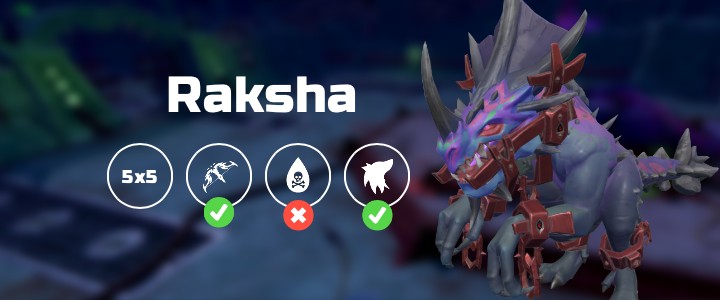Introduction to Necromancy Raksha
Raksha, the Shadow Colossus, is a formidable boss in RuneScape 3, known for its challenging mechanics and rewarding loot. Defeating Raksha efficiently requires mastery of combat rotations and a deep understanding of boss mechanics. This guide focuses on utilizing the Necromancy combat style to conquer Raksha, providing an advanced rotation that balances safety and maximizes damage output.
Necromancy offers a unique approach to bossing, and when executed correctly, it allows for both consistent pool clearing and rapid phase transitions at Raksha. This guide is designed for players who are already familiar with the basics of Necromancy and Raksha’s mechanics, aiming to elevate their gameplay to achieve faster and more reliable kills. By utilizing strategic ability sequencing, critical strikes, and precise movement, this Necromancy rotation will help you dominate Raksha.
Necromancy Presets and Relics for Raksha
To effectively execute the Necromancy rotation at Raksha, having the right gear and relics is crucial. A Tier 95 Necromancy weapon setup is highly recommended to maximize damage output. Utilizing optimal presets ensures you have all the necessary tools at your disposal for a smooth and efficient kill.
For preset suggestions, consider referring to resources like the PVME Preset Maker for a detailed Tier 95 Necromancy loadout tailored for Raksha. This preset typically includes high-tier Necromancy armor, weapon, and essential support items to enhance your damage and survivability.
Relics also play a significant role in optimizing your performance. Consider using relics that boost damage, such as Berserker’s Fury, which increases damage when your health is low, synergizing well with Necromancy’s life force mechanics. Other beneficial relics might include those that enhance critical hit chance or adrenaline gain.
Advanced Necromancy Rotation for Raksha
This Necromancy rotation for Raksha is designed for advanced players who want to optimize their kill times while maintaining safety during pool phases. It combines efficient pool clearing using Thread of Fate with a high-damage rotation on Raksha itself. Key elements for success include maximizing critical strikes, precise ability timing to avoid damage cap, and skillful player movement to maintain optimal positioning and ability ranges.
Remember to consistently use abilities effectively, avoiding the damage cap on high-hitting abilities to ensure no damage potential is wasted. Proper movement is also essential, especially for staying within range of Death Skulls and positioning behind Raksha to benefit from Soul Strike flank damage.
Pre-build Rotation
Before engaging Raksha, a pre-build sequence is essential to maximize initial damage output.
- War’s dummy: Start by using Soul Sap, followed by Thread of Fate, then Touch of Death, and another Soul Sap. Surge towards the crystal to initiate the fight.
- Instance Pre-build: Immediately upon entering the instance (and dropping combat if necessary), use Conjure Army, Life Transfer, Command Ghost, Invoke Death, Surge, Command Skeleton, Split Soul, and Vulnerability Bomb. Equip a ranged or magic main-hand weapon and use Ingenuity of the Humans.
This pre-build sequence ensures your summons are active, debuffs are applied, and you are ready to unleash a powerful burst of damage at the start of the fight.
Phase 1 Rotation
Phase 1 focuses on establishing a strong damage rotation while managing Raksha’s initial attacks.
- Begin with Time Compression (if available) and Smoke Cloud. Equip Omniguard and use Death Skulls.
- Follow with Soul Sap, Volley of Souls, Touch of Death, and another Soul Sap.
- Use Living Death and Adrenaline Renewal (note the conditional order below).
- Execute Touch of Death, Death Skulls, Bloat, Soul Sap, and Finger of Death.
Note: If your adrenaline is near 97% before Living Death, use Adrenaline Renewal first, then Living Death. Otherwise, use Living Death followed by Adrenaline Renewal as indicated above to optimize adrenaline management.
Phase 2 Rotation
Phase 2 requires mobility and precise positioning to maximize flank damage and manage Raksha’s movements.
- Start with a Necromancy auto-attack, followed by Soul Sap and Surge.
- Walk to the eastern edge of the arena to prepare for flanking.
- Use Soul Strike (flanking), Death Skulls, Touch of Death, Command Skeleton, and Finger of Death.
- Continue with two Necromancy auto-attacks, Finger of Death, Death Skulls, Bloat, Touch of Death, Soul Sap, and Command Skeleton.
- From this point, improvise and adapt your rotation based on cooldowns and Raksha’s health.
Phase 3 Rotation
Phase 3 is critical for efficient pool clearing and minimizing anima absorption.
- As Phase 3 begins, continue with two more abilities from the Phase 2 rotation to maintain damage pressure.
- Lure Raksha between two pools to prepare for clearing them with Thread of Fate.
- Execute the following sequence: Ability -> Ability + Surge -> Soul Strike (flank) -> Soul Strike (flank) -> Thread of Fate.
- Target the north or south pool with Soul Sap, then switch target back to Raksha and use Volley of Souls and Touch of Death.
- Finish the phase with Death Guard (90-second cooldown version) and Essence of Finality special attack.
- Continue with Necromancy auto-attacks, Soul Sap, or Volley of Souls until the phase transitions.
If executed correctly, this rotation will clear two pools, leaving only one set remaining and preventing Raksha from absorbing significant anima.
Phase 4 Rotation
Phase 4 is the final burst phase, requiring maximum damage output to finish the kill quickly.
- Start with Life Transfer and Dive.
- Use Bloat and Vulnerability Bomb.
- Follow with Soul Sap.
Handling a Stuck Skeleton: If your summoned skeleton gets stuck, quickly equip Excalibur, then equip Soulbound Lantern and use Conjure Army, Omniguard special attack, Command Ghost, and Command Skeleton to reposition and reactivate your summons.
Standard Phase 4 Rotation (if skeleton is not stuck): Command Skeleton, Omniguard special attack.
Continue the damage onslaught with: Soul Sap, Necromancy auto-attack, Touch of Death, Soul Sap, Necromancy auto-attack, Split Soul, Death Skulls, Bloat, Command Skeleton, Soul Sap, Necromancy auto-attack, Touch of Death, Necromancy auto-attack, Soul Sap, Volley of Souls, Inner Power, Death Guard (90-second cooldown version) and Essence of Finality special attack. Finish with Command Zombie, Command Skeleton, Touch of Death, or Finger of Death depending on cooldowns and Raksha’s remaining health.
Example Raksha Necromancy Kills
To see this Necromancy rotation in action, refer to these example kill videos:
- 1:35 Example Kill – Observe a fast kill showcasing the rotation’s potential.
- Average Example Kills – View a series of kills demonstrating consistent application of the Necromancy rotation.
These videos provide visual demonstrations of the rotation, ability timings, and movement strategies discussed in this guide, allowing you to refine your technique and achieve consistent Raksha kills with Necromancy.

